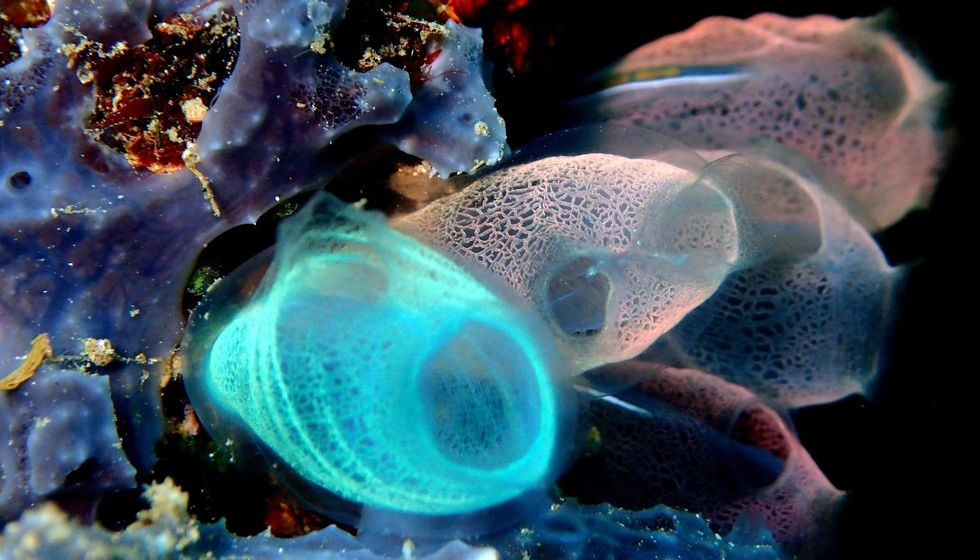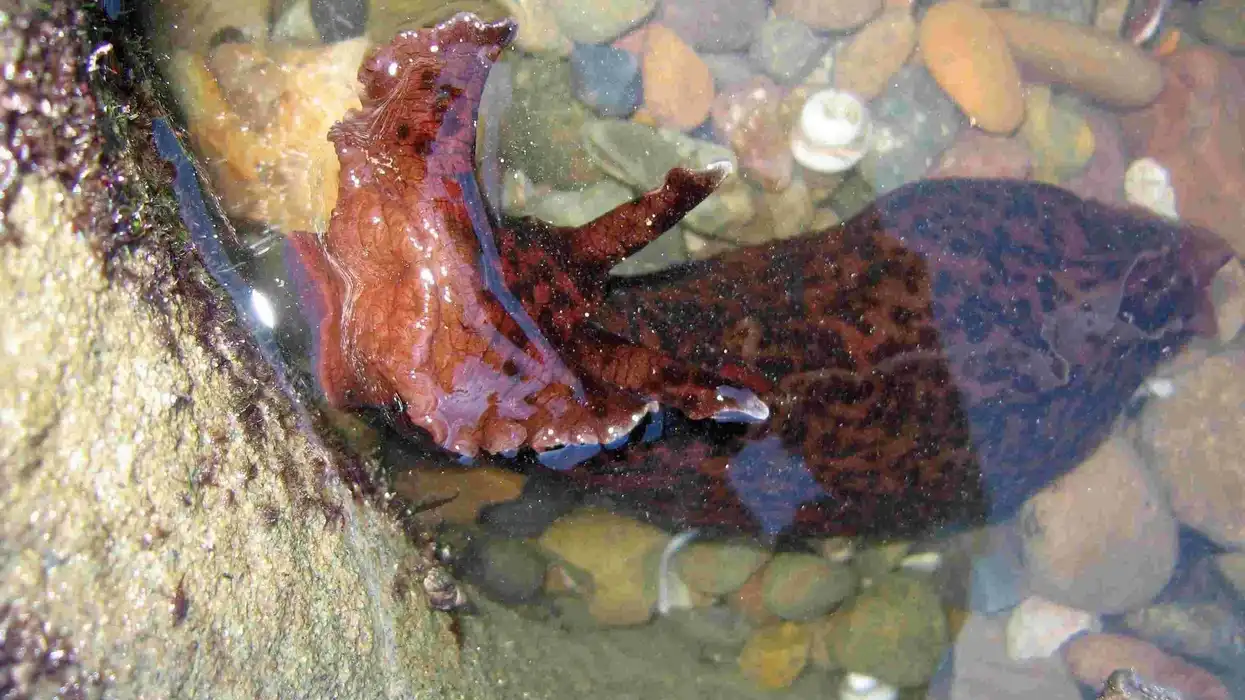Sea Squirts, commonly known as Ascidiacea, Ascidians, Tunicates, are marine species. Sea Squirts are sessile animals.
They are primarily found in potato shape, or tubular shape spotted resting on the hard surface like rocks and shells. Although petite, it has digestion, reproduction, circulation, and a nervous system.
The Sea Squirt is an invertebrate marine animal lacking a vertebral column or backbone. They have a tough outer layer made of Polysaccharides or Polycarbohydrates (usually found in food) known as 'Tunic,' and hence it got its name as Tunicates. The Sea Squirt or Ascidiacea was first termed in 1823.
The new Latin language inspires this name, Ascidia, with Greek roots from ascidion and askos, which mean wineskin or bladder. They are widely spread in the wild deep-sea in almost all parts of the world.
After discovering these interesting Sea Squirt facts, try reading our other articles about other marine animals like seahorse and barnacle found deep inside the sea.
Sea Squirt Interesting Facts
What type of animal is a Sea Squirt?
Sea Squirts are marine species that belong to the Chordata phylum group and subphylum Tunicata. It has a permeable tunic.
The tunic is composed of living tissues, muscle fibers, and a mere epithelium to have its blood supply. Some colonial species fused into a single structure. The body is mainly divided into three regions.
The pharyngeal region contains the pharynx surrounded by an atrium, an abdomen with most of the other bodily organs, and the postabdomen contains the heart and gonads. Tunicates have two siphons; one acts as an inhalant siphon from which water and food particles enter and exit through the atrial siphon.
What class of animal does a Sea Squirt belong to?
Although Sea Squirts belong to the Chordata phylum of vertebrate animals, they belong to the class Ascidiacea, a marine invertebrate.
How many Sea Squirts are there in the world?
The exact count of Sea Squirts is unknown. There are almost 2,300 species of Tunicates out of which we mainly find three types, namely Solitary, Social, and Compound ascidians.
Where does a Sea Squirt live?
Sea Squirts live in shallow depths of the sea, where salinity is more than 2.5%. Sea squirts are mostly seen at a depth of 28,000 ft (8,400 m) and a small population is also spotted on the seashore surviving under strong wave action.
A Tunicate is found attached to hard surfaces like pier pilings, ship hulls, rocks, seashells, and large crabs and oysters' backs. They can also survive on soft mud, sandy bottoms, or gravel grains.
What is a Sea Squirt's habitat?
Sea Squirts live under coastal waters around the world. They can be found from shallow depths to deep-sea attached to hard surfaces.
Who do Sea Squirts live with?
Sea Squirts live alone or in colonies. These colonies look similar to many grapes or rubbery blobs on the seafloor. A group of Sea Squirts is called zooid; these zooid bodies nestle together as one unit.
How long does a Sea Squirt live?
Sea Squirts' life span is 7-30 years in the wild, depending on the species and environmental conditions.
How do they reproduce?
Sea Squirts are hermaphrodites; hence, they possess male and female reproductive organs near the gut or body wall. Different Sea Squirts have different reproductive procedures; colonial forms can have mixed reproduction modes.
The colonial species fertilize with others by shedding eggs and sperm and into the sea. The tadpole-like larvae develop while these eggs and sperm are free-swimming. These larvae are planktonic.
The larvae metamorphose within 12-36 hours when attached to the anterior end of another individual's body with current water flow. Fertilization takes place, and the eggs are brooded inside.
Larval forms have the tail, with its notochord and nerve cord resemble tiny tadpole-like and later disappear in full-grown sea squirt. These tadpoles have a simple eye called ocellus and swim by undulating the tail balancing with a statocyst.
These larvae reach sexual maturity within a few weeks, find a suitable surface, and get attached to their permanent location. Most adult Sea Squirts are sessile and move by attaching with one area of the body and letting go. Reproduction of Tunicates also occurs by budding.
Chains of zooids break off into new individuals. With the adult Sea Squirts in social colonial Sea Squirts, the zooids remain independent, whereas in compound colonial Sea Squirts they bud to a colony.
What is their conservation status?
Sea Squirts are not an endangered species as they are found all most in every part of the world.
Sea Squirt Fun Facts
What do Sea Squirts look like?
Sea Squirts are rounded or cylindrical shaped, ranging from about 0.2-4 in (0.5-10cm). One end of the body is attached to the surface, gripping the substratum and the opposite surface of the animal has two openings called siphon. When removed from the water, they violently expel water from this siphon, hence getting the name Sea Squirt.
How cute are they?
Discovering Tunicates far beneath the ocean can be cute and incredibly adorable to watch in their juvenile form. Depending upon subspecies, they differ in color, shape, and size.
They are found in many colors, from fleshy beiges to brown, yellow, red, blue, green, orange, pink, and white. Another interesting type is the Skeleton Panda Sea Squirt with a spine and skull-like structure built with white tissues that resemble a panda.
How do they communicate?
Nature has unique ways of sending messages. Unlike other marine animals, Tunicates do not communicate over radio waves; instead, they have cellular conversations.
How big is a Sea Squirt?
When Sea Squirts invade a new place, they can quickly spread, replacing resident plants and animals. Each Tunicate is a few millimeters in size but can form colonies as large as 13 ft (396.2 cm) long.
Sea Squirts could be dangerous as they could create a vast dead zone and as their bodies break down, the oxygen consumed and released can foul the surrounding seawater.
How fast can Sea Squirts move?
Although Sea Squirts are sessile, they move slowly up to 0.6 in (1.5 cm) per day by attaching with one area of the body and letting go with another.
How much does a Sea Squirt weigh?
The average weight of Tunicates is 3.5-7 oz (100-200g).
What are their male and female names of the species?
Sea Squirts are hermaphrodites that include both male and female organs. Hence no separate terminology is given to determine a gender bias.
What would you call a baby Sea Squirt?
Tunicates have different modes of reproduction. Eggs are hatched to form larva within 36 hours and metamorphose into a juvenile. Later this juvenile turns into an adult form within a few weeks.
What do they eat?
Sea Squirt food includes debris from dead plants, animals and also gets some nutrients from algae that grow on their bodies. Some larger tunicates use tentacles to catch food particles floating in the water current, and some catch, jellyfish and other sea animals as food.
Are they harmful?
Sea Squirts can impact our ecosystem. They are master filter feeders and so, can remove plankton which are the main contributors to marine productivity and biomass.
Sea Squirts can be a significant base of the food web without which marine animals can be affected.
If Sea Squirts increase in huge numbers, large numbers of plankton are removed from the sea by which shrimp, crab, and other larvae are also removed.
Four species of Tunicates, namely Didemnum vexillum, Ciona sp., Botrylloides sp., and Stylea Clava, due to their fast reproduction rate and the absence of predators, can be a major threat to our ecosystem.
Some Sea Squirts also contain strong toxic chemicals and can secrete acids that help protect them from predators, which can be poisonous when consumed and pollute the entire structure.
Would they make a good pet?
Tunicates cannot make a pet. They can exist only deep in saline water.
Did you know...
Various Sea Squirt species are consumed as food all around the world. The Sea Pineapple is an edible Sea Squirt cultivated in Japan and Korea. It has a chewy texture and a peculiar taste like rubber.
Agujjim is a famous dish of Korea made of another species of Sea Squirt called Styela Clava. The Microcosmus Tunicate found in the Mediterranean Sea is in French, Italian, and Greek cuisines. The Piure Tunicate is part of Chilean cuisine consumed raw or added in seafood stews like Bouillabaisse.
Unusual features of the Sea Squirt
When larvae of Tunicates go through a metamorphosis, they get many physical changes like reducing their cerebral ganglion. Sea Squirts do not eat their brain as such, but since it absorbs the former cerebral material as it grows into its adult form, it became known for eating its brain.
What do humans have in common with Sea Squirts?
Sea Squirts are close to humans on an evolutionary scale. These invertebrate marine animals are not heartless.
Their heart is located in the post abdomen near the stomach. Through the water current, food particles and oxygen pass through gill slits in the pharynx from the inhalant siphon and are expelled through the exhalant siphon. These vessels are connected by a series of sinuses through which the blood flows.
A study on Tunicates, namely Star Sea Squirts, shows a pacemaker mechanism similar to that in the human heart. Like a human heart, pacemaker muscles in these Tunicates generate a signal and helps it contract and expand to pump blood.
Here at Kidadl, we have carefully created lots of interesting family-friendly animal facts for everyone to discover! Learn more about some other arthropods including giant African millipede, or flatworms.









